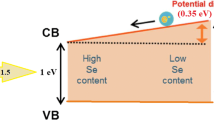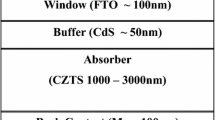Abstract
Earth abundant copper–zinc–tin–chalcogenide is an attractive class of materials for the fabrication of high efficiency, low cost, and sustainable thin-film solar cells. A CZTSSe solar cell was modeled and the effects of absorber layer band-gap grading were investigated. Regarding the tunable bandgap of kesterite absorber layers which is between 0.95 eV for CZTSe and 1.5 eV for CZTS, several grading models were simulated in SCAPS. First, using a set of comprehensive absorption data for CZTS and CZTSe, the basic bandgap was selected to be 1.15 eV due to experimental aspects, and then, five grading models namely back/front linear, back/front exponential, and inside graded were explored. The investigation of simulation results showed that the recombination rate improvement in back and front regions along with current density enhancement is achievable by these graded band-gap profiles. Finally, the modified inside graded model was reached to a power conversion efficiency of 15.6% which leaded to a considerable output performance.








Similar content being viewed by others
References
Z. Shi, D. Attygalle, A.H. Jayatissa, Kesterite-based next generation high performance thin film solar cell: current progress and future prospects. J. Mater. Sci: Mater. Electron. 28, 2290–2306 (2017)
F. Solar, First solar achieves yet another cell conversion efficiency world record., 201θ (2016)
P. Jackson, R. Wuerz, D. Hariskos, E. Lotter, W. Witte, M. Powalla, Effects of heavy alkali elements in Cu (In, Ga) Se2 solar cells with efficiencies up to 22.6%. Phys. Status Solidi (RRL)-Rapid Res. Lett. 10, 583–586 (2016)
G. Wang, W. Zhao, Y. Cui, Q. Tian, S. Gao, L. Huang et al., Fabrication of a Cu2ZnSn (S, Se) 4 photovoltaic device by a low-toxicity ethanol solution process. ACS Appl. Mater. Interfaces, 5, 10042–10047 (2013)
P. Darvishzadeh, H. Sohrabpoor, N.E. Gorji, Numerical device simulation of carbon nanotube contacted CZTS solar cells. Opt. Quantum Electron. 48, 480 (2016)
K. Woo, Y. Kim, W. Yang, K. Kim, I. Kim, Y. Oh et al., Band-gap-graded Cu2ZnSn (S1-x, Sex) 4 solar cells fabricated by an ethanol-based, particulate precursor ink route. Sci. Rep. 3, 3069 (2013)
W. Wang, M.T. Winkler, O. Gunawan, T. Gokmen, T.K. Todorov, Y. Zhu et al., Device characteristics of CZTSSe thin-film solar cells with 12.6% efficiency. Adv. Energy Mater., 4, (2014)
S.M. Yu, K.-S. Lim, A. Khalkar, J.-B. Yoo, Selenization of Cu2ZnSnS4 thin film using a Se metal-organic source for solar cell applications. Appl. Phys. A 122, 767 (2016)
D.B. Mitzi, O. Gunawan, T.K. Todorov, K. Wang, S. Guha, The path towards a high-performance solution-processed kesterite solar cell. Sol. Energy Mater. Sol. Cells 95, 1421–1436 (2011)
B. Shin, O. Gunawan, Y. Zhu, N.A. Bojarczuk, S.J. Chey, S. Guha, Thin film solar cell with 8.4% power conversion efficiency using an earth-abundant Cu2ZnSnS4 absorber. Prog. Photovoltaics Res. Appl. 21, 72–76 (2013)
S. Chen, X. Gong, A. Walsh, S.-H. Wei, Crystal and electronic band structure of Cu2ZnSnX4 (X = S and Se) photovoltaic absorbers: first-principles insights. Appl. Phys. Lett. 94, 41903 (2009)
S. Chen, A. Walsh, J.-H. Yang, X.-G. Gong, L. Sun, P.-X. Yang et al., Compositional dependence of structural and electronic properties of Cu 2 ZnSn (S, Se) 4 alloys for thin film solar cells. Phys. Rev. B 83, 125201 (2011)
S. Siebentritt, Why are kesterite solar cells not 20% efficient? Thin Solid Films 535, 1–4 (2013)
H. Wei, Z. Ye, M. Li, Y. Su, Z. Yang, Y. Zhang, Tunable band gap Cu 2 ZnSnS 4x Se 4 (1 − x) nanocrystals: experimental and first-principles calculations. Cryst. Eng. Comm. 13, 2222–2226 (2011)
K. Decock, J. Lauwaert, M. Burgelman, Characterization of graded CIGS solar cells. Energy Procedia 2, 49–54 (2010)
T. Dullweber, U. Rau, H. Schock, A new approach to high-efficiency solar cells by band gap grading in Cu (In, Ga) Se 2 chalcopyrite semiconductors. Sol. Energy Mater. Sol. Cells 67, 145–150 (2001)
N.E. Gorji, M.D. Perez, U. Reggiani, L. Sandrolini, A new approach to valence and conduction band grading in CIGS thin film solar cells. Int. J. Eng. Technol. 4, 573 (2012)
O. Lundberg, M. Edoff, L. Stolt, The effect of Ga-grading in CIGS thin film solar cells. Thin Solid Films 480, 520–525 (2005)
T.K. Todorov, K.B. Reuter, D.B. Mitzi, High-efficiency solar cell with earth-abundant liquid-processed absorber. Adv. Mater. 22 (2010)
M. Gloeckler, J. Sites, Efficiency limitations for wide-band-gap chalcopyrite solar cells. Thin Solid Films 480, 241–245 (2005)
M. Turcu, O. Pakma, U. Rau, Interdependence of absorber composition and recombination mechanism in Cu (In, Ga)(Se, S) 2 heterojunction solar cells. Appl. Phys. Lett. 80, 2598–2600 (2002)
A. Niemegeers, M. Burgelman, K. Decock, J. Verschraegen, “Stefaan Degrave SCAPS manual” ed: Version, 2014
N. Khoshsirat, N.A. Md Yunus, M.N. Hamidon, S. Shafie, N. Amin, Analysis of absorber and buffer layer band gap grading on CIGS thin film solar cell performance using SCAPS. Pertanika J. Sci. Technol. 23, 241–250 (2015)
S.H. Wei, A. Zunger, Band offsets and optical bowings of chalcopyrites and Zn-based II-VI alloys. J. Appl. Phys. 78, 3846–3856 (1995)
M. Burgelman, J. Marlein, Analysis of graded band gap solar cells with SCAPS, in Proceedings of the 23rd European Photovoltaic Solar Energy Conference, Valencia, 2008, pp. 2151–2155
M. Patel, A. Ray, Enhancement of output performance of Cu 2 ZnSnS 4 thin film solar cells—a numerical simulation approach and comparison to experiments. Physica B 407, 4391–4397 (2012)
O. Simya, A. Mahaboobbatcha, K. Balachander, Compositional grading of CZTSSe alloy using exponential and uniform grading laws in SCAPS-ID simulation. Superlattices Microstruct. 92, 285–293 (2016)
O. Simya, A. Mahaboobbatcha, K. Balachander, A comparative study on the performance of Kesterite based thin film solar cells using SCAPS simulation program. Superlattices Microstruct. 82, 248–261 (2015)
K. Ito, Copper zinc tin sulfide-based thin film solar cells. Wiley (2014)
H. ElAnzeery, O. El Daif, M. Buffiere, S. Oueslati, K. Ben Messaoud, D. Agten et al., Refractive index extraction and thickness optimization of Cu2ZnSnSe4 thin film solar cells. Phys. Status Solidi (a), 212, 1984–1990 (2015)
M. León, S. Levcenko, R. Serna, G. Gurieva, A. Nateprov, J. Merino et al., Optical constants of Cu2ZnGeS4 bulk crystals (2010)
S. Choi, H. Zhao, C. Persson, C. Perkins, A. Donohue, B. To et al., Dielectric function spectra and critical-point energies of Cu2ZnSnSe4 from 0.5 to 9.0 eV. J. Appl. Phys. 111, 033506 (2012)
K. Orgassa, H.W. Schock, J. Werner, Alternative back contact materials for thin film Cu (In, Ga) Se 2 solar cells. Thin Solid Films 431, 387–391 (2003)
M.A. Contreras, M.J. Romero, B. To, F. Hasoon, R. Noufi, S. Ward et al., Optimization of CBD CdS process in high-efficiency Cu (In, Ga) Se 2-based solar cells. Thin Solid Films 403, 204–211 (2002)
S. Siebentritt, Alternative buffers for chalcopyrite solar cells. Solar Energy. 77, 767–775 (2004)
M. Buffiere, G. Brammertz, S. Oueslati, H. El Anzeery, J. Bekaert, K.B. Messaoud et al., Spectral current–voltage analysis of kesterite solar cells. J. Phys. D: Appl. Phys. 47, 175101 (2014)
Author information
Authors and Affiliations
Corresponding author
Rights and permissions
About this article
Cite this article
Mohammadnejad, S., Baghban Parashkouh, A. CZTSSe solar cell efficiency improvement using a new band-gap grading model in absorber layer. Appl. Phys. A 123, 758 (2017). https://doi.org/10.1007/s00339-017-1371-x
Received:
Accepted:
Published:
DOI: https://doi.org/10.1007/s00339-017-1371-x




